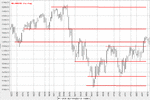August 24: Preparation
Setup:
- Put up a chart of the past months and draw long term S/R lines.
- Put up a chart of the last month and draw intermediate term S/R lines.
- Put up yesterday's chart and draw short term S/R lines.
- Before the day opens, make sure these lines are visible on today's chart.
- Draw new S/R lines throughout the day, wherever applicable.
- Pay closer attention when price moves towards a S/R zone.
- Check if price breaks this level or reverses from it.
- If it breaks through, check if it's happening on a WRB closing above the middle (doesn't have to be one single bar).
- Check how far price moves above the R (or below the S).
- If price moves away for 10 points, then wait for a retracement back to the line.
- When the retracement happens, there you have a entry possibility.
---
Plan:
Long term S/R levels:
6200, 5950, 5800, 5750, 5575, 5400, 5300
Medium term S/R levels:
5850, 5825, 5775, 5750 ,5725, 5615
Short term S/R levels:
5830, 5810, 5795, 5772.50
Take only long and medium term S/R levels that appear on the chart of the next day and are within a "reasonable" range of the previous trading day ranges. E.g. 6200 or 5300 are outside of that.
5850: Long after price breaks up through this level on upside and moves to 5860 or further, before recoiling back to the line. Stop is at ATR, first target is 2x ATR, second 3x ATR, because ATR is dynamic and objective. Enter with two contracts, two different targets, definining a minimum risk/reward of 1:2. After first target hit, move stop to BE. This then defines the exit.
5825: Long after price breaks up through this level on upside and moves to 5835 or further, before recoiling back to the line. Stop is at ATR, first target is 2x ATR, second 3x ATR, because ATR is dynamic and objective. Enter with two contracts, two different targets, definining a minimum risk/reward of 1:2. After first target hit, move stop to BE. This then defines the exit.
5775: Long after price breaks up through this level on upside and moves to 5785 or further, before recoiling back to the line. Stop is at ATR, first target is 2x ATR, second 3x ATR, because ATR is dynamic and objective. Enter with two contracts, two different targets, definining a minimum risk/reward of 1:2. After first target hit, move stop to BE. This then defines the exit.
5750: Long after price breaks up through this level on upside and moves to 5760 or further, before recoiling back to the line. Stop is at ATR, first target is 2x ATR, second 3x ATR, because ATR is dynamic and objective. Enter with two contracts, two different targets, definining a minimum risk/reward of 1:2. After first target hit, move stop to BE. This then defines the exit.
5725: Long after price breaks up through this level on upside and moves to 5735 or further, before recoiling back to the line. Stop is at ATR, first target is 2x ATR, second 3x ATR, because ATR is dynamic and objective. Enter with two contracts, two different targets, definining a minimum risk/reward of 1:2. After first target hit, move stop to BE. This then defines the exit.
In turn, this depends on where price opens the next day: taking only long position of course when the trend is up and price is moving up through that resistance level, shorting when the general trend is down and prive breaks the support. For instance:
5775: Short after price drops through this level on downside and moves to 5765 or further, before recoiling back to the line. Stop is at ATR, first target is 2x ATR, second 3x ATR, because ATR is dynamic and objective. Enter with two contracts, two different targets, definining a minimum risk/reward of 1:2. After first target hit, move stop to BE. This then defines the exit.
5750: Short after price drops through this level on downside and moves to 5740 or further, before recoiling back to the line. Stop is at ATR, first target is 2x ATR, second 3x ATR, because ATR is dynamic and objective. Enter with two contracts, two different targets, definining a minimum risk/reward of 1:2. After first target hit, move stop to BE. This then defines the exit.
5725: Short after price drops through this level on downside and moves to 5715 or further, before recoiling back to the line. Stop is at ATR, first target is 2x ATR, second 3x ATR, because ATR is dynamic and objective. Enter with two contracts, two different targets, definining a minimum risk/reward of 1:2. After first target hit, move stop to BE. This then defines the exit.
Let me know what's still missing.





